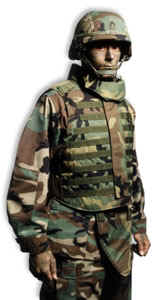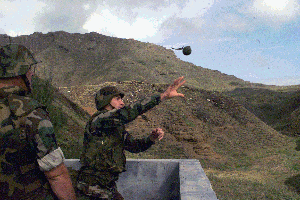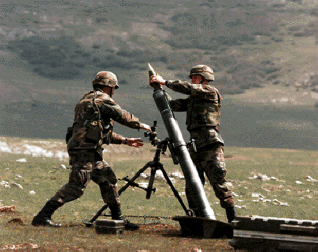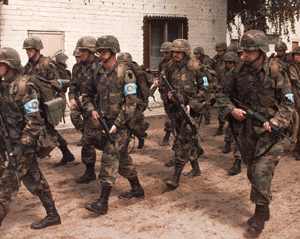Would any professional sports team trade half their players every year and skip pre-season training? Of course not, yet this is how the US Army fights wars. Soldiers need to train for months to develop teamwork. However, the continual turnover of personnel makes training difficult. The solution is "rotational readiness", an idea used by the US Navy and Marine Corps where units or ships train for a six-months prior to a six-month forward deployment. All peacetime Armies should adopt this concept, but with an 18-month cycle to increase the "ready for war" period to one year.
Units should rotate readiness in groups of three, among divisions, brigades, or battalions. For this example, we'll rotate brigades, so an Army division can have two "ready" brigades, and one "refit" brigade. Each brigade rotates through an 18-month cycle with 6-months of refit followed by 12-months "ready", which fits nicely into the typical four-year personnel tours. Most all new soldiers finish their basic and advanced training within a year, so they can spend three years in two 18-month cycles with the same unit.
Six Month Refit 
To understand a "ready" brigade, you must understand what happens during a six-month "refit" stage. During the last few months of a one-year ready stage, the unit will evaluate the records of all soldiers. Orders will be prepared for those due transfer, which will be about half the brigade. A thousand more will leave the Army during the next 18-months, so leaders will discuss options with each soldier. Anyone wanting to serve another 18-month cycle will have to extend his enlistment or delay his retirement to remain with the unit. Otherwise, they will be discharged a few months early or transferred to a nearby base support unit.
All this data will be fed into the Army personnel system so they can identify replacements. As a result, about half the brigade will have transfer orders in hand when the one-year ready period ends. During a war or crisis, the President will institute a "stop-loss" to halt all transfers and extend service in the brigade for the duration. Otherwise, the day the one-year ready cycle ends, the brigade is listed as "not combat ready" and begins a six-month refit stage. Each component of the brigade will use a different training plan, but here is a general idea:
1st Month (personnel turnover)
The first month of refit will be devoted to "out-process" the two thousand soldiers leaving the brigade, and "in-process" the three thousand soldiers who will replace them. The extra thousand soldiers provide the attrition cushion needed for today's Army and will bring the brigade up to 120% strength. All change-of-command formalities will occur along with an equipment inventory and turnover of equipment among responsible officers. Everyone in the brigade gets their annual dental and medical check-ups during the first two months of refit.
One advantage of this massive personnel turnover is that soldiers who just finished their basic and specialty training can be shipped to the same brigade, and should be assigned the same companies when possible. This is extremely important for building unit cohesion, and helps young soldiers deal with loneliness and improves retention and morale. Soldiers who just completed their first 18-month cycle will become NCOs soon, so the brigade will send them through a 4-6 week NCO school during these first two months, ideally run by the local base or division headquarters. They will be promoted to corporal upon graduation.
2nd Month (leave)
The brigade is now at 120% strength with all soldiers restricted to service with the brigade for the next 17 months. However, the two thousand soldiers who just finished the "ready year" are due vacation (called leave). The US military allows 30 days a year, and only emergency leave is granted during the ready year. Therefore, most of these soldiers will be gone for up to a month for leave. The new arrivals may also be granted leave as many need time to look for family housing and to settle in the base. No training will occur during this month as the entire brigade "stands-down" for leave, or to finish NCO school. However, soldiers will be told the next four months will be long hours with many days away from home.
3rd Month - (equipment maintenance/upgrades)
No unit training will occur this month
other than physical fitness as the entire brigade focuses on equipment
issues. The annual detailed preventive maintenance checks will occur as
all weapons and equipment are issued, inspected, repaired, or replaced. (The
Army must modify its annual requirements to 18-months for this
system). Contractors and civilians will arrive to install upgrades or
introduce new equipment. They will train soldiers to use new gear and
learn about equipment problems encountered during the last year.
4th Month (qualifications)
Most soldiers need to "qualify" with the weapons or equipment. This is often done at live fire ranges. NCOs will ensure their new soldiers know their jobs and weapons as training begins at the squad and platoon level.
5th and 6th Month (unit training)
Company level exercises begin and advance to the battalion and brigade level. The entire brigade prepares to deploy to a major exercise which lasts 2-3 weeks. This may occur at a distant national training center, or a large outside training staff will arrive to support a local exercise. A key element is to put the entire brigade in the field to exercise the logistical components. This means cooking hot chow the field, setting up field aid stations, hauling the admin people and their computers into the field, performing maintenance in the field, and even minor things like field mail delivery. This is rarely exercised in peacetime as Generals prefer to see tanks rolling rather than latrines dug. The training evolution will end two weeks before the "ready year" period begins to allow clean up and a week of leave before the one-year no-leave period.
Reserve Training
This refit concept is perfect for
reserve mobilization, except the 2nd month for leave will be skipped. Reserve units
are rarely fully manned and never fully trained. However, they provide a
nucleus in which active duty and individual reservists can be added. Few
soldiers realize that some 100,000 well-trained individual ready reservists
who do not belong to units but left active duty within the past couple of years can be mobilized. Reserve combat units from small communities must also be "diluted", as
they are in every war. Generals have learned that you cannot throw a rifle
company from a single small town into a bloody battle. When the casualty
list appears, the local townsfolk would be devastated and investigations begun
as to what happened and why that unit was chosen. As a result, personnel
planners need to shuffle personnel in some units.
Once regular army officers become accustomed to the idea of unit refits, they can easily adapt the idea to reserve mobilization. Some reserve officers will dislike the implication that their units are not ready for war. However, regular army units are not ready for war either. Any honest officer in today's army will admit that his unit needs more some training time prior to deployment due to the constant personnel shuffle and random training system.
The Training Team
The Navy and Marine Corps have struggled with issue of whether outside elements should help train units, or evaluate them. It seems simple to hold the brigade commander responsible for training his unit, but that poses problems. Half the brigade staff just arrived on base, most take leave, and then must begin an intense four-month training period. Such training requires months of preparation to ensure firing ranges and training areas are reserved, and things like transport, fuel, and ammo are on hand. This challenge becomes worse if evaluators or unofficial observers from higher headquarters roam about looking for mistakes which tarnish the overburdened brigade staff. This causes intense stress among officers and a preference to "looking good" rather than "training good".
A better approach is to assign a colonel from the Division G-3 section to coordinate the refit of brigades. His
team will have weeks to prepare everything even before the brigade forms.
This same group coordinates training for each of the division's brigades, so they will have proven methods and clear
timetables. They will ensure that equipment upgrades and outside trainers
are ready and everything flows smoothly. If difficult training results in
accidents, unit commanders are not held responsible. The brigade and
battalion staff will work with the Division refit training team to ensure realistic
training with the help of experts from throughout the Army. This allows brigade officers time to undergo training themselves: rifle
qualifications, refresh radio procedures, learn new computer software, attend
classes on new equipment, and participate in command post exercises and war game
simulators. 
Ready Year
In today's Army, 36% of soldiers fail to finish their first enlistment. This rate should be lower with rotational readiness since most privates will arrive with their friends from school training and the brigade will be involved in a meaningful and well-planned training cycle. However, around 10% will have dropped out over the past six months, leaving the brigade at 110%. Another 10% will be lost over the next year, a lower rate because of the easier routine.
One problem in today's Army is that overtime costs nothing. As a result, soldiers are pushed endlessly to prepare for the next training event to develop teamwork with the latest crop of new arrivals. After four months of intense training during a refit stage, continual training is unnecessary since there will be no personnel turnover. Soldiers endured the four intense training months knowing that the ready year has strict limits of 32 work hours a week. Unit commanders will decide how to organize the 32 hours, maybe four days a week, or shorter days. Generals will monitor this constraint to ensure a quality of life.
The unit may deploy for a local joint exercise, followed by many days off. If the Army wants to retain qualified people, it must learn to compensate for extra hours. In addition, a brigade cannot remain ready for immediate deployment if equipment is heavily used and broken. The brigade may be tasked to provide demonstrations, called "dog and pony shows", for VIPs or provide manpower for base events. It may also support training of refit brigades. Tasking brigades in the refit stage to perform any outside tasks will be strictly forbidden by the Army.
The first task for a brigade beginning a "Ready Year" is an embarkation exercise so every soldier understands where to go and what to do if an urgent deployment order is issued. Some brigades may deploy overseas for a few months as a forward presence. This is actually good for morale, followed by 20-hour work weeks upon return as these "ready" brigades spend time with friends and families. A deployment order will not require any preparation as soldiers execute the carefully planned movement to a port of embarkation. It will take weeks to deploy the division's two "ready" brigades, and the third brigade will follow as it finishes its refit stage. Rotational Readiness will allow US Army divisions to immediately deploy fully trained brigades into combat.
Carlton Meyer editorG2mil@Gmail.com
©2002 www.G2mil.com